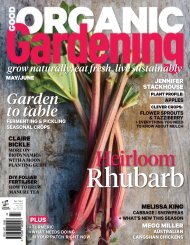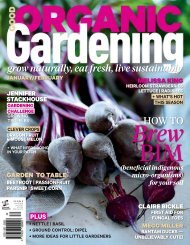5. Good Organic Gardening - September-October 2016 AvxHome.in
5. Good Organic Gardening - September-October 2016 AvxHome.in
5. Good Organic Gardening - September-October 2016 AvxHome.in
You also want an ePaper? Increase the reach of your titles
YUMPU automatically turns print PDFs into web optimized ePapers that Google loves.
PEST PATROL | Queensland fruit fly<br />
Hygiene<br />
Don’t leave fruit on your trees or<br />
vegetables <strong>in</strong> the garden until they are<br />
over-mature as these conditions are<br />
ideal for QFF to lay <strong>in</strong>. Pick up any fallen<br />
fruit or vegetables that are no good,<br />
put them <strong>in</strong> a sealed bag and dispose<br />
of them <strong>in</strong> the b<strong>in</strong>. Don’t compost them,<br />
as you are only promot<strong>in</strong>g a suitable<br />
source for QFF to lay <strong>in</strong>.<br />
Beautifully netted fruit trees at Royal Mail<br />
Hotel kitchen garden <strong>in</strong> Dunkeld, Victoria<br />
have been the most effective control for<br />
commercial fruit growers, these chemicals<br />
also killed beneficial <strong>in</strong>sects that assist <strong>in</strong><br />
controll<strong>in</strong>g <strong>in</strong>sect pests and so those pests<br />
began to be hard to control. Many of these<br />
chemicals are no longer available for use.<br />
Other techniques to control QFF have been<br />
developed by proactive horticulturists and<br />
fruit growers and have been <strong>in</strong> use by some<br />
growers for 15 years. These are not harmful to<br />
beneficial <strong>in</strong>sects so they can now be used <strong>in</strong><br />
the home garden<strong>in</strong>g sector.<br />
The ma<strong>in</strong> control methods that will make<br />
the battle with QFF easier for the home<br />
gardener <strong>in</strong>clude the follow<strong>in</strong>g:<br />
Full exclusion nett<strong>in</strong>g<br />
Permanent structures or drape nets are<br />
the most successful control measures. It’s<br />
important that these nets be secured to the<br />
ground to prevent QFF gett<strong>in</strong>g underneath<br />
the nett<strong>in</strong>g. This should be <strong>in</strong> place before<br />
fruit and vegetables are half mature as QFF<br />
will sometimes st<strong>in</strong>g fruit and vegetables<br />
when they are still hard. They may not<br />
lay eggs at this time, but they will leave a<br />
p<strong>in</strong>-sized mark on the sk<strong>in</strong> that will cause<br />
a deformity, or the fruit or vegetable may<br />
drop off as it grows.<br />
Bait<strong>in</strong>g<br />
Prote<strong>in</strong> baits that attract both male and female<br />
fruit flies are applied to the lower foliage of<br />
plants and should also be used to bait the<br />
perimeter of your house block. Bait can be<br />
applied to any type of tree or shrub. This<br />
control measure should be used <strong>in</strong> conjunction<br />
with trapp<strong>in</strong>g male flies with female fruit fly<br />
pheromone attractant baits hung <strong>in</strong> traps.<br />
This process reduces the number of male flies<br />
available to mate with female flies.<br />
The whole process must beg<strong>in</strong> <strong>in</strong> late<br />
w<strong>in</strong>ter to keep the numbers of flies down<br />
as they emerge with the warm<strong>in</strong>g spr<strong>in</strong>g<br />
weather. Please note that control measures<br />
of this type are difficult if your neighbours’<br />
untreated crops are hosts for QFF; hence<br />
even more reason to bait the perimeter of<br />
your own yard so flies will feed there first<br />
before mov<strong>in</strong>g to your fruit and vegetables.<br />
Queensland fruit fly maggots<br />
For home gardeners<br />
who have no experience<br />
<strong>in</strong> identify<strong>in</strong>g this pest,<br />
by the time they realise<br />
they have damage it’s<br />
very often too late.<br />
F<strong>in</strong>e mesh bags<br />
These can be purchased and tied around<br />
fruit and vegetables but they’re timeconsum<strong>in</strong>g<br />
to apply and therefore not really<br />
a good option for large numbers of fruit or<br />
vegetables. Unless vented, the plastic bags<br />
available for bagg<strong>in</strong>g create humidity and<br />
have been known to promote fungal diseases<br />
as the fruit or vegetable matures. Bags need<br />
to be clear so sunlight can penetrate to the<br />
fruit or vegetable sk<strong>in</strong> to give good colour and<br />
therefore good flavour.<br />
Tim<strong>in</strong>g<br />
QFF is most active from early spr<strong>in</strong>g through<br />
to late autumn.<br />
Fruit fly trap<br />
• For more <strong>in</strong>formation on fruit-fly control<br />
techniques and products consult PlantNet at<br />
plantnet.com.au<br />
Home remedies/<br />
attractants<br />
Please be aware there are many home<br />
remedies suggested for the control of<br />
QFF. It’s important that you learn to<br />
identify what QFF looks like as many of<br />
the suggested catch-and-kill remedies<br />
actually don’t attract QFF but do attract<br />
other <strong>in</strong>sects and flies, leav<strong>in</strong>g your<br />
crops vulnerable to damage by QFF.<br />
Kerry Boyne, Mark Dann, Jana Holmer<br />
56 | <strong>Good</strong> <strong>Organic</strong> <strong>Garden<strong>in</strong>g</strong>

















